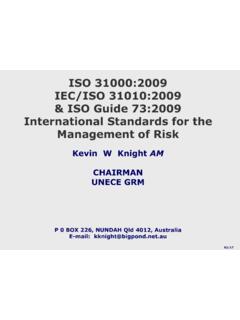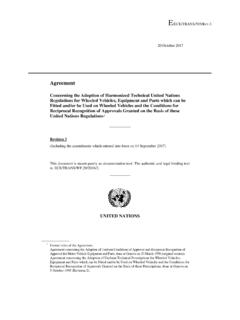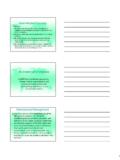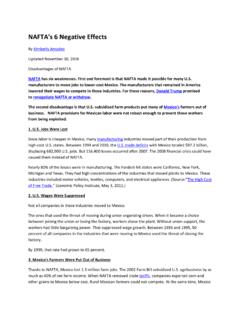Transcription of Chapter 5: Composite Economic Indicators
1 1 Chapter 5: Composite Economic Indicators Contents Introduction .. 1 Arguments for and against Composite Economic Indicators .. 2 Composite Economic Indicators , some definitions .. 3 Cyclical Composite Economic Indicators .. 5 Non-Cyclical Indicators .. 8 Structural Indicators .. 9 Steps for construction of Composite Economic Indicators .. 10 Recommendations .. 18 References .. 19 Introduction Composite Economic Indicators (CEI) has been in use for many years. One of the first and most known Composite Indicators is the Conference Board Leading Indicators1. The main reason for developing Composite Economic Indicators was to anticipate movements of the reference variable that the indicator aimed to measure, mainly GDP. The Handbook of Cyclical Composite Indicators (forthcoming)2 presents a historical overview of this area.
2 Starting in the midst of the 19th century the first theories provided the first exogenous cycles relating Economic cycles to other exogenous cycles found in nature such as weather. At first, a single indicator was formed to appropriately describe Economic fluctuations. This was developed to synthetic indicator (or barometer) which combined homogenous set of single Indicators representing a specific Economic sector or a particular aspect of the Economic fluctuations3. This synthetic indicator was the first Composite Economic indicator . Although, Composite Economic Indicators (CEI) has been in use for a long time, to assess the present Economic situation, it was not until the aftermath of the Great Recession of 2008-2009 that users demanded Indicators that were more streamlined.
3 This was required, as a more homogenous set of statistical Indicators would make it possible to give a reliable overall picture of the Economic situation and allow for cross-country comparisons and users would more easily be able to make the correct decisions. The main purpose for constructing and producing Economic Composite Indicators have been a search for early warning measures, such as leading or coincident Indicators as measures of cyclical turnings points. The Indicators are used to compare Economic development between countries. The methodology used in the construction of CEIs has varied over time and between producers. The Indicators should be based on statistical reliable data and economically sound methods to secure good quality. 1 The Conference Board (2012) 2 UN/Eurostat ( forthcoming) 3 UN/Eurostat (forthcoming) 2 Structure of the Chapter This Chapter aims to present the most used standard model for Composite Economic Indicators and discuss their usage to give guidance to NSOs how to deal with these models.
4 The guide will also highlight issues and pitfalls that the NSOs should be aware of when constructing CEIs and give examples of their construction today. Section presents gives an overview of different definitions for Composite Economic Indicators . Section describes cyclical Indicators with or without reference series. Chapter discusses structural Indicators and Chapter gives an overview of the recommended model for construction of Composite Economic Indicators , which includes a discussion of quality issues and dissemination. Finally, a few examples are presented in the annex, which illustrates Indicators produced within the official statistics. The Chapter draws upon the Handbook on Cyclical Composite Indicators (UNSD, Eurostat forthcoming), the Handbook on constructing Composite Indicators (OECD 2008) and the OECD system of Composite leading Indicators (OECD 2012).
5 Arguments for and against Composite Economic Indicators There is an ongoing discussion on pros and cons for using Composite Indicators . The main advantages is that the Indicators can summarize complex, multi-dimensional concepts in an easier way and make it easier to compare country performance over time. From a policy-makers point of view it will also be easier to follow the trend of few Composite Indicators than exploring large amount of statistical datasets. Composite Economic Indicators may also offer leading abilities that makes it possible to predict the present Economic development in a convenient way. However, there are also many arguments for not producing Composite Economic Indicators . The methods used are not in line with the statistical requirements regarding the choice of individual indicator and methods for weighting and aggregations.
6 Often the conceptual model or theory does not exist and there is a need for time and resources for further research to clarify these requirements. Even it a robust model is applied, there is a risk of failure over time as the Economic conditions are changing. This means that the NSO have to put in more work in evaluation and further development to secure quality in the Composite indicator over time. As resources are often scarce, this will be a disadvantage. Even if the Composite Indicators is demanded by users there are risks as users do not have the skills to judge the Indicators and it might send misleading messages if poorly constructed or misinterpreted. Users may make simplistic conclusions, as they do not know the underlying data well enough. The Composite Indicators may also be misused to support a desired policy, or they may be misunderstood if it is not transparent enough for users to understand.
7 The NSOs have to weigh the pros and cons and it might be a matter of resources for many of them. Larges countries with NSOs that have enough resources to hold a methodology department with an analytic capacity will have abilities to develop Composite Economic Indicators for national use. For smaller countries, or NSOs with restricted budgets, this may be something that has to be down-priorities as it is not possible to hold enough methodological resources. Some NSOs have found ways to cooperate with research institutions, such as Switzerland or the Netherlands, to make it possible to produce Composite Indicators , but this might not be an option for everyone. 3 Composite Economic Indicators , some definitions A Composite indicator is constructed by compiling individual Indicators into a single index, based on an underlying model of the multi-dimensional concept that is being measured4.
8 The Composite Economic Indicators (CEI) are the most used Composite Indicators and the components that build these Indicators usually origins from statistics. The CEIs have two dimensions; macroeconomic Indicators and structural Indicators , which both describe the Economic change. A structural change in the economy is permanent or very long-lived, while a macroeconomic disturbance tend to return to its previous level over a few The macroeconomic Indicators have two dimensions; cyclical or non-cyclical Indicators depending on whether they have reference series or not. The cyclical Indicators that have a reference series, usually GDP, can be leading, coincident and lagging Indicators depending on their timing. The non-cyclical Indicators do not follow any reference series but give additional information of the causes for the short-term change in the economy.
9 The advantage of using CEI compared to the use of individual component series is that it achieves a better tradeoff between responsiveness and stability. The CEI have the capacity to react to various sources of Economic fluctuations, no matter whether the causes are endogenous or exogenous at the same time can they be resilient as only part of the components are affected. Due to the large interest in predicting business cycles, Composite Economic Indicators have mainly been used in a cyclical context. However, these Indicators are increasingly used also in a structural context, as the importance of the real understanding of the causes for permanent change in the economy are increasing. Examples on this are analysis of phenomena s such as innovation, productivity, digitalization and organizational learning, as a base for all policy areas associated with these challenges.
10 CEIs, that compare country performance, are a useful tool in policy analysis and policy communications. Using Composite Economic Indicators to identify common trends across many separate areas (countries) may be a complementary tool, when comparing many different Indicators presented at a dashboards or scoreboards . While the Composite Indicators give a time series perspective over the Economic situation for a set of Indicators , the dashboard/scoreboard presents many Indicators at one point in time, or in relation to a set goal. Further analysis and research is needed to analyze the present situation over time. Composite Indicators and dashboards/scoreboards can be complementary tools and the choice of tool depends on user s needs. While the CEI signals a changing trend, the dashboard/scoreboard can give more information on the cause of the change.

















